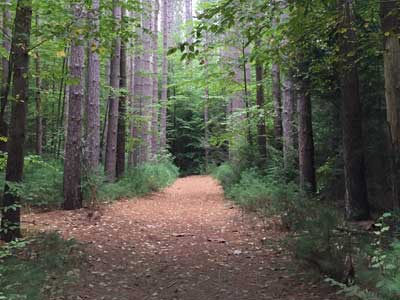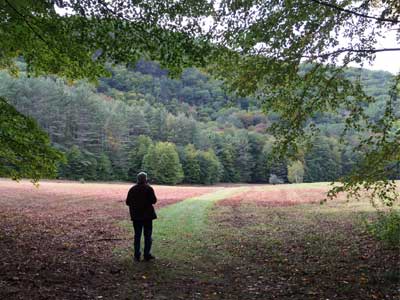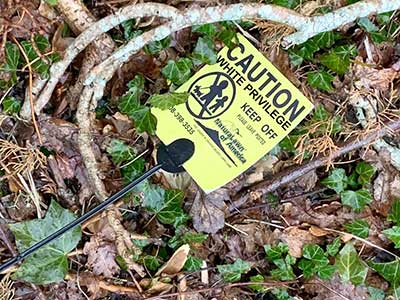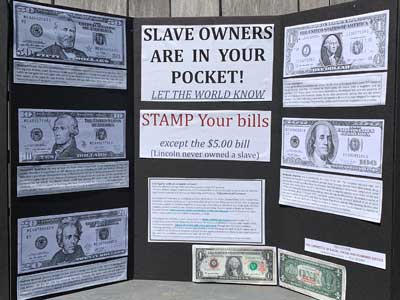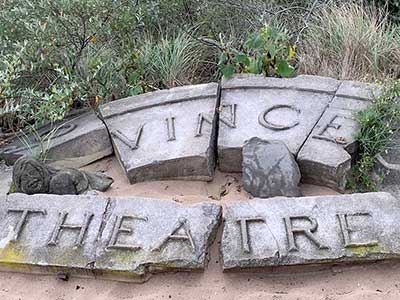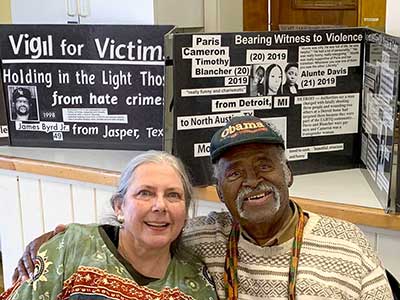by Anagha Srikanth | July 2021
Thousands of papers, some documenting the auction and sale of enslaved Black Americans, were headed for the auction block themselves before Black historians and community members stepped in to reclaim ownership over their past. “It was important to the community because this will connect the dots for people and the younger generation, to let them know how things were. To move forward, you have to see what the past was like,” said Carolyn Brooks, a community historian with the Chesapeake Heartland Project. About 2,000 pages dating from the late 1600s to early 1800s were found in a plastic trash bag in the attic of a 200-year-old house near Chestertown, Maryland, as the owner, Nancy Bordely Lane, was cleaning it out this spring. The foundation of the house, built in 1803 on property that had remained in the family since 1667, was reportedly damaged and the structure was going to be demolished. The documents were headed for the garbage, but were rescued and delivered to Dixon’s Crumpton Auction in waxed seafood boxes, John Chaski, an antique-manuscript expert, told the Washington Post.
TAGS: [Strategies] [2020’s] [Slavery] [History] [Systemic Racism] [Art & Culture] [Racial Terrorism] [White Supremacy] [White Culture]
Resource Links Tagged with "Art & Culture"
A slave Mother’s Love in 56 Carefully Stitched Words
by Amina Al-Sadi & Jeannie Yandel | December 2016
For about $300, a 9-year-old girl named Ashley was sold as a slave.
Her mother, Rose, remained a house slave at a mansion in South Carolina. This was the 1850s, roughly a decade before Abraham Lincoln’s Emancipation Proclamation, setting slaves free. Before mother and daughter were separated, Rose gave Ashley a cotton sack. It contained a tattered dress, three handfuls of pecans and a lock of her hair. Rose told Ashley it was filled with love — always. Ashley never saw her mom again, but she kept the sack. It was handed down through the generations, along with her story, to her granddaughter, Ruth Middleton. Ruth, a single mom in Philadelphia, stitched her family story into the cloth sack in 1921…. Nearly 100 years later, the bag was found at a flea market in Tennessee. A woman bought it and donated it to Middleton Place, a famous plantation in South Carolina that refuses to shy away from its awful history.
TAGS: [Racial Terrorism] [2010’s] [Slavery] [History] [Art & Culture] [Civil War]
Understanding the History and Traditions of Día de los Muertos; Mexican American Studies Scholar Michelle Téllez Gives An Overview of the Autumn Holiday of Mourning That Originated in Mexico and is Now Celebrated Around the World.
by Kyle Mittan, University Communications |October 2021
Anyone who’s spent a few autumns in Tucson will know the signs of the changing season, especially the cooler temperatures and the increase in drivers on the road as snowbirds return. But the appearance of some other, more unique, symbols also mark the occasion. Calaveras, or skulls – often in the form of edible, decorative sugar skulls – and papel picado, pieces of colorful paper with intricately cut-out designs, are ubiquitous in southern Arizona come October, but what do they mean? They’re icons of Día de los Muertos, or Day of the Dead – a holiday with roots in Mexico that is now celebrated all over the world.
TAGS: [Assumptions] [2020’s] [Latino/a] [Indigenous] [Definitions] [Art & Culture]
This Church Is Paying ‘Royalties’ When It Sings Spirituals Composed by Enslaved Africans
by Craig LeMoult | November 2021
A hundred or so masked parishioners in the pews of the United Parish in Brookline joined together at a recent service and sang “Lord, I Want To Be A Christian In My Heart.” This song, like many that churches sing all over the country, comes from a musical tradition of spirituals originally composed by African people enslaved in America. As a national reckoning with racism has grown over the last year or so, members of the United Parish began asking whether it was appropriate for the predominantly white church to sing these songs. To address those concerns, the church introduced a unique program to help carry on the legacy of this music in Roxbury, and they’re hoping to be a model for others. “There was growing discomfort around how to use Negro spirituals, appropriately and respectfully,” said the congregation’s minister of music Susan DeSelms.
TAGS: [Collective Action] [2020’s] [Slavery] [Systemic Racism] [Reparations] [Art & Culture]
10 pieces of Art to Help You Engage with Truth and Reconciliation; Recommendations from Indigenous Artists and Curators for Films, Books, Theatre and Visual Art
by CBC Arts | September 2021
To mark the first formally recognized National Day For Truth and Reconciliation, CBC Arts reached out to Indigenous curators and artists with one important question: what pieces of art should Canadians engage with to better under the ideas behind truth and reconciliation? The answers we got ranged from films to books to works of theatre to specific pieces of visual art. We invite you to spend some time with these works today.
TAGS: [Collective Action] [2020’s] [Indigenous] [Art & Culture] [Social Justice]
Native Americans and Mount Rushmore
by From the Collection: Native Americans | Date Unknown
The creation of Mount Rushmore is a story of struggle — and to some, desecration. The Black Hills are sacred to the Lakota Sioux, the original occupants of the area when white settlers arrived. For some, the four presidents carved in the hill are not without negative symbolism. The Sioux have never had much luck dealing with white men. In the Treaty of 1868, the U.S. government promised the Sioux territory that included the Black Hills in perpetuity. Perpetuity lasted only until gold was found in the mountains and prospectors migrated there in the 1870s. The federal government then forced the Sioux to relinquish the Black Hills portion of their reservation.These events fit the pattern of the late 19th century, a time of nearly constant conflict between the American government and Plains Indians. At his second presidential inauguration in 1873, Ulysses S. Grant reflected the attitudes of many whites when he said he favored a humane course to bring Native Americans “under the benign influences of education and civilization. It is either this or war of extermination.” Many of the land’s original occupants did not choose to assimilate; for them war, was the only option.”
TAGS: [Strategies] [Indigenous] [Racial Terrorism] [Systemic Racism] [Silencing POC] [White Supremacy] [White Culture] [White Blindness] [Politics] [Social Justice] [History] [White Privilege] [Prison System] [Art & Culture]
Opinion: Why Norman Rockwell Left Thanksgiving Americana behind
by Andrew L. Yarrow | November 2021
At this time of year, Norman Rockwell is best remembered for his iconic 1943 painting “Freedom From Want,” depicting a smiling White family gathered around a Thanksgiving turkey. But it is less well known that he decisively turned a corner just a few decades later, choosing to reject the airbrushed image of a nation implicitly populated with only happy, White, middle-class families.
TAGS: [Strategies] [2020’s] [Systemic Racism] [Prison System] [Policing] [Black Lives Matter] [Art & Culture] [White Supremacy] [White Culture] [White Privilege] [History] [Politics] [Social Justice]
Why Issa Rae Says Diversity Questions Should Be Asked Of White People Who Run the Industry
by Jordan Simon | February 2020
“Every time there’s an interracial romance, it feels like it centers on whiteness, and it doesn’t have to,” the Insecure star said to Variety. “Just so you know, there are people who don’t procreate with just white people.” In the wake of Joaquin Phoenix’s speech at the BAFTAs calling out institutional racism and discrimination in Hollywood, Rae said it’s about time discussions on inclusion be asked of the white people make major decisions in the film and television industry. “I don’t feel like it’s up to me to answer those questions. Like, I’m doing the work. I’m out here. I’m employing who I need to employ, I’m telling the stories that I need to tell,” she said. “Those questions need to be asked to the powers-that-be. It needs to be asked to the white people who run this industry.”
TAGS: [Strategies] [2020’s] [Art & Culture] [White Culture] [Systemic Racism] [White Privilege] [Employment]
Private Museums Could Face NAGPRA Scrutiny; Museums and Other Institutions that Accept Stimulus Funds Could Be Required to Repatriate Indigenous Artifacts and Remains
by Nanette Kelley | May 2021
Small museums and private institutions that accept federal CARES Act money or other stimulus funds could be forced to relinquish thousands of Indigenous items and ancestral remains now in their collections.
Under the Native American Grave Protection and Repatriation Act of 1990, museums or other institutions that accept federal funding must compile an inventory of Indigenous cultural items and initiate repatriation of the collections and remains to tribes or family members. At least two museums are now facing possible scrutiny – the nonprofit Favell Museum of Native American Artifacts and Contemporary Western Art in Klamath Falls, Oregon, and the End of the Trail Museum, which is connected to the Trees of Mystery gift shop in the redwood forest in Klamath, California.
TAGS: [Assumptions] [2020’s] [Indigenous] [Art & Culture] [Silencing POC] [History] [Politics] [White Supremacy] [White Culture] [Economics] [Systemic Racism] [Advocacy] [Social Justice]
‘Nomadland’ and the Supremacy of White People Problems; What’s the Strongest Liquid on Earth (and in Hollywood)? White Girl Tears
by Jeremy Helligar | January 2021
My 15-year-old niece recently floored her mother with some Black, bruising teen spirit: “What is the strongest liquid on earth?” she asked. Answer: “White girl tears.” It’s a revelation that has haunted me since my sister-in-law shared it with me. They live minutes away from Hollywood, a place on earth where hallowed White women have been crying themselves to Oscars for nearly a century. In 92 years of Academy Awards, Halle Berry remains the only Black woman whose tears have been strong enough to score a gong for Best Performance by an Actress in a Leading Role. Only 11 others have been nominated in the category, none more than once.
TAGS: [Individual Change] [2020’s] [White Fragility/Tears] [Art & Culture] [Asian] [Politics] [White Culture] [White Blindness] [White Privilege] [Black Lives Matter] [Latino/a] [Economics]
No More ‘Redface:’ Lost Colony Production Will No Longer Hire White Actors for Native American Roles
by Heather Leah| April 2021
After 83 years of production, The Lost Colony will no longer cast white actors in ‘redface’ for Native American roles. First staged in 1937, the popular outdoor play tells the mysterious and tragic story of the Roanoke Colony in North Carolina. The historic change was prompted by an online petition by Adam Griffin that demanded the play “stop performing racist, redface performances.” The petition, which has been signed by over 600 people, calls the play out for bronzing or painting the skin of white actors so that they appear “like Native Americans.” Griffin’s petition says this is a form of blackface, coined as “redface.”
TAGS: [Collective Action] [2020’s] [Indigenous] [Art & Culture] [Denial] [History] [Employment]
Whitewashing the Great Depression; How the Preeminent Photographic Record of the Period Excluded People of Color from the Nation’s Self-Image
by Sarah Boxer | December 2020
Quick, name one iconic Depression-era portrait each by Dorothea Lange, Walker Evans, and Russell Lee. My guess is that you’d choose Lange’s Migrant Mother, a portrait of Florence Owens Thompson and her children taken in Nipomo, California, in 1936. For Evans, you’d probably pick a 1936 portrait of tight-lipped Allie Mae Burroughs standing before the wall of her family’s cabin in Hale County, Alabama. For Lee, you might draw a blank, but you’d likely recognize his 1937 group portrait Saturday Night in a Saloon, showing four drinkers in Craigville, Minnesota. (It was used in the opening sequence of the TV show Cheers.)
TAGS: [Assumptions] [2020’s] [Silencing POC] [White Culture] [White Privilege] [White Supremacy] [Art & Culture] [History] [Systemic Racism] [White Defensiveness] [Politics] [Denial]
Okinawans Exhibit Artful Way of Reclaiming Indigenous Space
by Megumi Chibana | April 2021
Note: This article originally appeared in Verge 4.2 (Fall 2018), published by the University of Minnesota Press.
In 1995, the Okinawan community of Yomitan — which had been dispossessed of their lands during the Pacific War to allow for the building of a Japanese airfield — revealed their plans for the future of their village. Village leaders placed an image and a poem at the center of this new vision, an artful way of imagining indigenous space…. In 1995, the Japan-US Special Action Committee on Okinawa, or SACO, agreed on joint use of the Yomitan Airfield. Although the permission provided only for “interim use,” the repossession and use of the airfield by the village opened new space for the community. Through self-organization and the reconfiguration of space, the village successfully refuted the military use of indigenous space and regenerated the landscape as a democratic hub for deliberating alternative futures. This is when the community developed and detailed the Phoenix Plan, as a new vision to imagine indigenous space.
TAGS: [Strategies] [2020’s] [Art & Culture] [History] [Politics][Indigenous] [White Supremacy] [White Culture] [White Privilege] [Reparations] [Social Justice]
Henry Ossawa Tanner: The Life and Work of a 19th-Century Black Artist
by Arnesia Young | February 2021
The 19th century was not an easy time to be a Black person in America, especially if you were trying to make it as an artist. For that reason, it is extremely remarkable to note when an American artist of African descent is able to rise above the racial discrimination so prevalent during that time period and become a renowned artist of international acclaim. Henry Ossawa Tanner was one such artist, and he was able to achieve that impressive feat during his lifetime. While he struggled with the complexities and the implications of his race and heritage, Tanner ultimately persevered and was able to develop his talent in a variety of genres. His artwork and story leave a lasting legacy that has impacted many Black artists who’ve followed since.
TAGS: [Strategies] [2020’s] [Art & Culture] [History] [Role Model] [Slavery] [Black Lives Matter]
In Artist Adrian Brandon’s Incomplete Portraits, A Year of Life Equals One Minute of Color
by Grace Ebert | June 2020
When Adrian Brandon starts to color a portrait, he sets a timer. For his rendering of Breonna Taylor, the clock is set to 26 minutes—for George Floyd, 46 minutes, for Tony McDade, 38, and for Aiyana Stanley Jones, just seven. “When the alarm sounds, I am hit with a wave of emotions ranging from anger, to deep sadness, to hopelessness, to feeling lucky that I am still here,” he says. The Brooklyn-based artist is working on Stolen, a series of partially filled-in depictions of Black people murdered by police. Each portrait remains incomplete as Brandon only colors one minute for each year of the subject’s life before it was cut short. “Aside from being able to give the viewer a visual of the various ages affected by police violence, the timer creates a lot of anxiety for me as the artist,” he says, wondering, “’When is the timer going off?’ ‘Will I be able to finish this eye?’ ‘Damn, I haven’t even gotten to the lips yet.’”
TAGS: [Strategies] [2020’s] [Art & Culture] [Racial Terrorism] [Police Shootings] [Policing] [Systemic Racism] [Black Lives Matter] [Advocacy]
The Decline of Black Business; and What it Means for American Democracy
by Brian S. Feldman | May 2017
The last thirty years also have brought the wholesale collapse of black-owned independent businesses and financial institutions that once anchored black communities across the country. In 1985, sixty black-owned banks were providing financial services to their communities; today, just twenty-three remain. In eleven states that headquartered black-owned banks in 1994, not a single one is still in business. Of the fifty black-owned insurance companies that operated during the 1980s, today just two remain. Over the same period, tens of thousands of black-owned retail establishments and local service companies also have disappeared, having gone out of business or been acquired by larger companies. Reflecting these developments, working-age black Americans have become far less likely to be their own boss than in the 1990s.
TAGS: [Strategies] [2010’s] [Art & Culture] [Justice System] [History] [Economics] [Systemic Racism] [Black Lives Matter] [Social Justice] [Politics] [Slavery] [Civil War] [White Supremacy] [White Privilege] [Racial Covenants] [Racial Terrorism]
Peabody Museum Apologizes For Practices Around Native American Cultural Objects, Announces Policy Changes
by Oliver L. Riskin-Kutz | March 2021
Peabody Museum of Archaeology and Ethnology administrators apologized for the “pain” the museum caused by its refusal to voluntarily return certain funerary objects to Native American tribes and pledged to reverse the policy in response to a letter from the Association on American Indian Affairs last month criticizing the museum. In February, the Association sent a letter to University President Lawrence S. Bacow accusing Harvard of legal and moral violations in the Museum’s practices regarding its collections of Native American human remains and cultural objects. In the letter, the nonprofit said Harvard’s practices are in violation of the Native American Graves Protection and Repatriation Act.
TAGS: [Strategies] [2020’s] [Indigenous] [Art & Culture] [Systemic Racism] [White Culture] [Social Justice]
The Samuel George Morton CRANIAL COLLECTION; Historical Significance and New Research
by Emily S. Renschler and Janet Monge | Month Unknown 2008
Although few visitors to the Museum would know this, the Samuel George Morton cranial collection at the University of Pennsylvania Museum of Archaeology and Anthropology is one of the most famous collections of human skulls in the entire world. Its presence in Philadelphia is the result of the collecting activities of Samuel George Morton (1799–1851), a Philadelphian who actively participated in the vibrant medical and scientific community that spanned the Atlantic Ocean in the early 19th century.
TAGS: [Assumptions] [2020’s] [Art & Culture] [History] [Slavery] [Indigenous] [Black Lives Matter] [Latino/a] [Myths] [White Supremacy] [White Privilege] [White Culture] [Systemic Racism]
Black Opera Composer Is Dismissed Over Lyrics for 100-Year Commemoration of the Tulsa Race Massacre
by Shanelle Genai | March 2021
When composer Daniel Roumain was commissioned to create an original work for “Greenwood Overcomes,” a celebration led by the Tulsa Opera to recognize the 100th anniversary of the Tulsa Race Massacre, I’m sure he never thought one lyric would be enough to lose him the commission. Unfortunately, it was. As Vulture reports, Roumain composed an aria inspired by the horrific details of the massacre titled They Still Want to Kill Us, with the last two lines reading: “God bless America/God damn America.” But when mezzo-soprano singer Denyce Graves, who was set to perform the aforementioned song, expressed concerns over those lines—Tulsa Opera asked Roumain if he would consider changing the lyrics. He said no, and now, both Roumain and his work are now no longer a part of the celebration.
TAGS: [Assumptions] [2020’s] [Silencing POC] [Systemic Racism] [History] [Art & Culture] [-ing While Black] [Black Lives Matter] [Denial] [White Defensiveness] [White Supremacy] [White Privilege] [White Blindness] [White Fragility/Tears]
The Treaty That Forced the Cherokee People from Their Homelands Goes on View
by SMITHSONIAN VOICES | April 2019
On Friday, April 12, 2019, representatives of the three federally recognized tribes of the Cherokee people—the Cherokee Nation of Oklahoma, Eastern Band of Cherokee Indians, and United Keetoowah Band of Cherokee Indians in Oklahoma—came together at the National Museum of the American Indian in Washington, D.C., for the installation of the Treaty of New Echota in the exhibition Nation to Nation: Treaties Between the United States and American Indian Nations. Negotiated in 1835 by a minority party of Cherokees, challenged by the majority of the Cherokee people and their elected government, the Treaty of New Echota was used by the United States to justify the forced removal of the Cherokees from their homelands along what became known as the Trail of Tears.
TAGS: [Strategies] [2010’s] [Indigenous] [History] [Art & Culture] [White Supremacy] [White Culture] [Systemic Racism] [Politics] [Justice System]
This African American Woman Got No Credit for Designing the Image of Roosevelt on the U.S Dime in 1944
by Elizabeth Ofosuah Johnson | August 2018
Selma Burke was born on December 31, 1900, and was the 7th of ten children to her parents. Her father worked in the railway service and was a church minister, while her mother was a stay at home mom. At a very young age, Selma showed artistic skill and would often draw or carve objects out of used paper and cardboard. … In 1943, Selma entered a national competition which she won. Sponsored by the Fine Arts Commission in Washington D.C, the competition was to create a profile portrait of the then U.S. President Franklin Delano Roosevelt with a granted commission. Selma then wrote a letter to the president and was invited to the White House to do her sketch.
TAGS: [Assumptions] [2010’s] [Systemic Racism] [History] [Art & Culture] [Silencing POC] [Myths] [Black Lives Matter] [Denial] [White Culture] [White Privilege] [White Supremacy]
“I Am My White Ancestors” Claims the Legacy of Oppression; An Artist’s Journey into Her Family’s Whiteness
by Nancy Hill | March 2019
“I am about to turn over a goodly number of acres to cotton and have added more slaves to total 50. They were a large investment with housing and such. … We have heard that some states in the north have gone against nature and profit to prohibit slaves. … Without slaves, where do they expect to get cotton, tobacco, molasses, and rice? … Sometimes I do wonder if the slaves are truly as simple and childlike as some say. When I put some up for sale, I see their mothers stand there and openly weep. Imagine! Perhaps they really do feel as we do. But I banish that thought from my mind. … I am a good and kind master. These African slaves could not survive without me. They are better treated here than in the heathen land they come from. We clothe them and feed them, give them shelter and medical care and the discipline they need They have the benefit of civilized and white society.” —John Salley, 1740-1794, excerpt from audio story about Salley
TAGS: [Individual Change] [2010’s] [Slavery] [Systemic Racism] [White Supremacy] [White Culture] [White Defensiveness] [White Privilege] [White Blindness] [History] [Black Lives Matter] [Indigenous] [Art & Culture] [Anti-Racism]
Why Have I Never Heard of This?’: Phila Orchestra Revives America’s First Black Woman Composer
by Peter Crimmins | February 2021
Florence Price had one of her pieces performed in 1933, by the Chicago Symphony Orchestra. Since then, she has disappeared from the classical canon. “She shouldn’t be an obscure composer. It’s sensational music that’s been overlooked,” said Orchestra CEO Matías Tarnopolsky. “It raises questions of how canons of music are made. Here we have this brilliantly creative compositional voice that has been largely unheard since her death in the middle of the 20th century.” “In the musical world we have to ask: Why is this the case?” he added.
TAGS: [Assumptions] [2020’s] [Art & Culture] [Silencing POC] [White Privilege] [White Culture] [White Blindness] [History]
What Do We Do About John James Audubon?
by J. Drew Lanham | Spring 2021
The founding father of American birding soared on the wings of white privilege. The birding community and organizations that bear his name must grapple with this racist legacy to create a more just, inclusive world. Last summer, the Sierra Club denounced its first president, John Muir, as a racist unworthy of organizational adulation. Muir is a founding father of the American wilderness movement; he also characterized Blacks as lazy “sambos” and Native Americans as “dirty.” The National Audubon Society followed suit, stating that Audubon, too, was a racist. He enslaved at least nine people. He mostly referred to them as “servants” and “hands,” but never seemed especially concerned that the people helping him could be bought, sold, raped, whipped, or killed on a whim. Then again, relatively few men of his time did. Presidents did not. Why would he? Audubon’s callous ignorance wouldn’t have been unusual for a white man. It would have been de rigueur—an expectation of race and class that he enjoyed.
TAGS: [Collective Action] [2020’s] [Slavery] [History] [White Supremacy] [White Culture] [White Privilege] [Accountability] [Systemic Racism][-ing While Black] [Environment] [Myths] [Black Lives Matter] [Indigenous] [Implicit Bias] [Cognitive Dissonance] [Art & Culture]
How the History of Blackface Is Rooted in Racism
by Alexis Clark | February 2019
Blackface began in the US after the Civil War as white performers played characters that demeaned and dehumanized African Americans. The portrayal of blackface–when people darken their skin with shoe polish, greasepaint or burnt cork and paint on enlarged lips and other exaggerated features, is steeped in centuries of racism. It peaked in popularity during an era in the United States when demands for civil rights by recently emancipated slaves triggered racial hostility. And today, because of blackface’s historic use to denigrate people of African descent, its continued use is still considered racist. “It’s an assertion of power and control,” says David Leonard , a professor of comparative ethnic studies and American studies at Washington State University. “It allows a society to routinely and historically imagine African Americans as not fully human. It serves to rationalize violence and Jim Crow segregation.”
TAGS: [Collective Action] [2010’s] [History] [Systemic Racism] [Civil War] [White Supremacy] [White Culture] [White Privilege] [Art & Culture] [Assumptions] [Myths] [White Blindness] [Social Justice] [Economics]
New Native American Memorial Offers Peace in the Heart of One of the City’s Few Wild Spaces
by Philip Kennicott | December 2020
The wetlands on the grounds of the Smithsonian’s National Museum of the American Indian are one of the most serene and magical spots in all of Washington. It counters by example the larger argument of the Mall, which is all about symmetry, extended vistas and monumental scale. With trees and grass and a bit of water, this garden is a quiet but forceful rejoinder to the bombast and imperial ambition that surrounds it. With a little imagination, you might pretend that somehow the great brush of history missed this one small spot where the landscape looks just as it did in pre-Columbian times.
TAGS: [Strategies] [2020’s] [Indigenous] [History] [Art & Culture]
This Waltz Once Attributed to Strauss Is Actually by Indigenous Mexican Composer Juventino Rosas
by Stephen Raskauskas | May 2017
The waltz is typically associated with composers from German-speaking countries. The word waltz is, after all, German. Viennese composers like Beethoven and Schubert composed waltzes. Viennese composer Johann Strauss II was known as the “Waltz King.” But at the same time that the Viennese were waltzing around ballrooms and clinking their champagne glasses, the people of Mexico were enjoying waltzes, too, many of which were composed in Mexico. One of the most famous waltz composers in Mexico was Juventino Rosas. He was born in 1868 in Santa Cruz de Galeana to parents who were Otomí. The Otomí people are one of many indigenous groups in Mexico. In 2015, over 25,000,000 people living in Mexico identified as indigenous.
TAGS: [Assumptions] [Indigenous] [2010’s] [Latino/a] [Myths] [Art & Culture] [Implicit Racism] [History] [Silencing POC]
The Brutish Museums by Dan Hicks Review – Return Everything; A Powerful Call for Western Museums to Return the Objects Looted in the Violent Days of Empire, During ‘World War Zero’
by Charlotte Lydia Riley | November 2020
The book is a vital call to action: part historical investigation, part manifesto, demanding the reader do away with the existing “brutish museums” of the title and find a new way for them to exist, not as sites of violence or trauma but as “sites of conscience”. Hicks is a curator at the Pitt Rivers Museum in Oxford, whose website says that it displays “archaeological and ethnographic materials from all parts of the world”. He focuses on one particular region – the kingdom of Benin, now located in modern Nigeria.
TAGS: [Assumptions] [2020’s] [History] [Art & Culture] [Systemic Racism] [Denial] [White Supremacy] [White Culture] [Racial Terrorism] [Economics] [Slavery] [Reparations]
Alexander Hamilton, Enslaver? New Research Says Yes; A Paper by a Researcher at the Schuyler Mansion Finds Overlooked Evidence in Letters and Hamilton’s Own Account Books Indicating That He Bought, Sold and Personally Owned Slaves.
by Jennifer Schuessler | November 2020
“Not only did Alexander Hamilton enslave people, but his involvement in the institution of slavery was essential to his identity, both personally and professionally,” she writes. “It is vital,” she adds, “that the myth of Hamilton as ‘the Abolitionist Founding Father’ end.” The evidence cited in the paper, which was quietly published online last month, is not entirely new. But Ms. Serfilippi’s forceful case has caught the eye of historians, particularly those who have questioned what they see as his inflated antislavery credentials.
TAGS: [Assumptions] [2020’s] [Slavery] [White Supremacy] [White Culture] [White Privilege] [Art & Culture] [Denial] [Myths]
Yiddisher Black Cantors from 100 Years Ago Rediscovered Thanks to Rare Recording
by Renee Ghert-Zand | November 2020
Early 1920s newspaper ads for the blockbuster New York Yiddish stage shows Dos Khupe Kleyd (The Wedding Dress) and Yente Telebende (Loquacious Battle‐Ax), featured a Black artist among the spotlighted performers. This was Thomas LaRue, a Yiddish-speaking singer widely known in the interwar period as der schvartzer khazan (The Black Cantor). Although long-forgotten now, LaRue (who sometimes used the surname Jones) was among the favorites of Yiddish theater and cantorial music. Reportedly raised in Newark, New Jersey, by a single mother who was drawn to Judaism, he even drew interest from beyond the US.
TAGS: [Assumptions] [2020’s] [Systemic Racism] [Black Lives Matter] [White Supremacy] [White Privilege] [White Culture] [White Blindness] [History] [Cognitive Dissonance] [Art & Culture]
